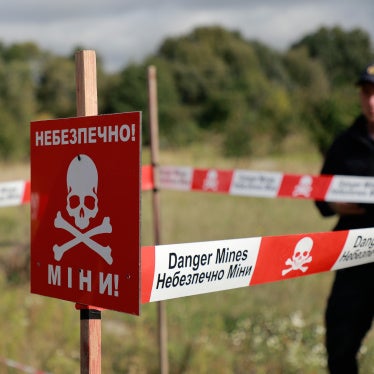Thank you for the floor, Madame Chair.
We appreciate the many positive and detailed updates we have just heard.
Stockpile destruction is one of the fundamental obligations of the Convention on Cluster Munitions. The obligation to not just stop use, but to destroy existing stocks as soon as possible, with an eight year deadline, is one of the key reasons why the Convention is such a strong international instrument. Simply put, stockpile destruction prevents future use of millions and millions of submunitions, saving untold numbers of lives and avoiding untold numbers of injuries.
Political will is the key to successful stockpile destruction - not technical expertise or unlimited resources. Experience thus far with the Convention on Cluster Munitions shows that stockpile destruction is not a daunting matter, that in most cases it will not be too technically challenging or too costly for States Parties and signatories. There are relatively simple and inexpensive methods available that may be appropriate for many States Parties.
A key lesson from the Mine Ban Treaty experience with stockpile destruction is to start early. May I repeat, start early. Virtually all missed deadlines, and nearly missed deadlines, for that treaty were the result of a state waiting too long to get the process started.
If states act with urgency, and give stockpile destruction the proper political and budgetary priority, there should be no missed deadlines for stockpile destruction in the Convention on Cluster Munitions, and no need to request deadline extensions. States Parties should set this as a shared objective: no stockpile destruction deadline extension requests. If the United Kingdom, which had one of the largest stocks of current States Parties, is able to finish destruction five years ahead of its deadline, so can others.
The Vientiane Action Plan reflects this approach to stockpile destruction. Action #8 calls on States Parties to have a plan in place for destruction within one year of entry into force, including a timeline and budget, and to begin physical destruction as soon as possible - which in our view should be within two years.
For some States Parties, an important reason for having a plan in place within one year is to be able to identify the need for any assistance from others, be it technical or financial. Action #9 of the Vientiane Action Plan calls for timely disclosure of obstacles to destruction and the need for assistance.
We have prepared a Cluster Munition Monitor Fact Sheet on stockpiles and their destruction. We welcome any corrections, clarifications, or updates. We are pleased to report that states are off to an impressive start in fulfilling this obligation. We have seen dynamic progress in a short period of time.
There is no doubt that the task is large. While some observers have claimed that the Convention is for those who do not possess significant stocks, so far 14 State Parties have declared in their initial Article 7 transparency reports possessing at some point in time nearly one million clusters munitions (994,573) containing over 140 million explosive submunitions.
Eight States Parties have already declared that they have finished stockpile destruction, including some even before the Convention entered into force. Those states are: Austria (in November 2010), Belgium (August 2010), Ecuador (2004). Moldova (July 2010), Montenegro (October 2010), Norway (July 2010), Portugal (before entry into force), and Spain (March 2009).
A number of signatories have also completed destruction. We just heard from Hungary, and offer our congratulations. Colombia and the Czech Republic finished last year, Afghanistan and Angola have reported completion in recent years, and Australia and Honduras have said their stocks were destroyed even before the Oslo Process. Canada has just provided details on its destruction thus far.
Based on Article 7 reporting, a total of 10 States Parties have reported that 589,608 cluster munitions containing over 64.4 million submunitions have been destroyed. This includes information submitted by States Parties on destruction before entry into force. The Monitor fact sheet provides a breakdown of cluster munitions and explosive submunitions reported destroyed by each State Party.
All States Parties with stocks have indicated they have either begun the physical destruction of stockpiles or are in the process of having a plan in place to do so. All have indicated that they will complete the task before their eight year deadline. These are impressive and encouraging early returns on fulfillment of this crucial obligation.
Methods of destruction have varied widely depending on various factors. Some states have shipped their stocks to destruction facilities in other countries, some have disassembled their weapons domestically, recycling some components and destroying others, some have financed their own destruction and some have received international assistance. Details are provided in the Monitor Fact Sheet. For those with smaller stockpiles, working with NGOs with experience in this area-such as Norwegian People's Aid as we saw in a previous presentation-can be an efficient and cost-effective way to meet the obligation.
In terms of costs, six States Parties indicated in their transparency reports that a total of approximately €150 million has been allocated so far to the destruction of stockpiles. The costs of destroying stockpiles are as varied as the methods chosen.
In closing, we would like to note that eight States Parties have clearly indicated in their Article 7 reports that they do not possess stockpiles, and another eight have noted on the relevant form "not applicable" or "none." We urge these latter states to declare more clearly they have no cluster munitions stockpiled.
The other 27 States Parties are either late in submitting their initial transparency reports, or the reports are not due yet. We eagerly anticipate these reports so that States Parties and all other interested parties can get a better picture of the progress and challenges in stockpile destruction.
If you will allow me two final words: start now!








